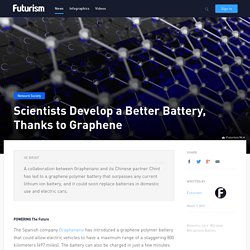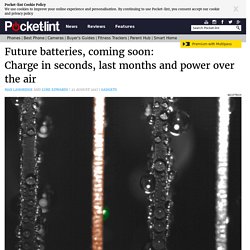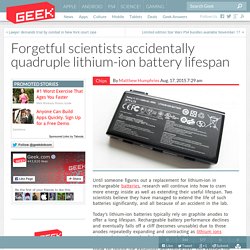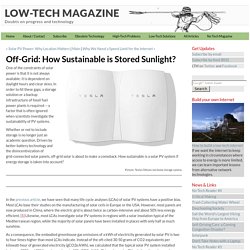

Scientists Develop a Better Battery, Thanks to Graphene. In Brief A collaboration between Graphenano and its Chinese partner Chint has led to a graphene polymer battery that surpasses any current lithium ion battery, and it could soon replace batteries in domestic use and electric cars.

POWERING The Future The Spanish company Graphenano has introduced a graphene polymer battery that could allow electric vehicles to have a maximum range of a staggering 800 kilometers (497 miles). The battery can also be charged in just a few minutes. And it could do more than revolutionize electric cars. The company notes that the battery is designed for a number of uses, and could be put in houses, bicycles, drones, and even pacemakers. Future batteries, coming soon: charge in seconds, last months and power over the air. While smartphones, smarthomes and even smart wearables are growing ever more advanced, they're still limited by power.

The battery hasn't advanced in decades. But we're on the verge of a power revolution. Big technology and car companies tare all too aware of the limitations of lithium-ion batteries. While chips and operating systems are becoming more efficient to save power we're still only looking at a day or two of use on a smartphone before having to recharge. Thankfully, universities are getting involved. Boosting the efficiency of solar panels. A UConn researcher has developed a light-harvesting antenna that could double the efficiency of existing solar cell panels and make them cheaper to build.

Professor Challa V. Kumar, who holds appointments in the departments of Chemistry, Molecular and Cell Biology, and the Institute of Materials Science, and his team have created a gel that enhances the ability of solar cells to absorb energy from sunlight. Sunlight strikes Earth every day with more energy than is used globally in a year. But finding an efficient way to capture and store solar energy to replace fossil fuels as the world's go-to energy source remains a challenge. "Most of the light from the sun is emitted over a very broad window of wavelengths," says Kumar, who recently presented his work at the 250th National Meeting & Exposition of the American Chemical Society in Boston.
Taking inspiration from plants, the team used a mixture of biodegradable materials to collect sunlight, much like plant chlorophyll. Solar Cells Made Obsolete. Revolutionary new solar windows can generate 50 times more energy than conventional photovoltaics. Forgetful scientists accidentally quadruple lithium-ion battery lifespan. Until someone figures out a replacement for lithium-ion in rechargeable batteries, research will continue into how to cram more energy inside as well as extending their useful lifespan.

Two scientists believe they have managed to extend the life of such batteries significantly, and all because of an accident in the lab. Today’s lithium-ion batteries typically rely on graphite anodes to offer a long lifespan. Rechargeable battery performance declines and eventually falls off a cliff (becomes unusable) due to those anodes repeatedly expanding and contracting as lithium ions migrate during the cycle of charging and discharge. Lithium compounds build up on the electrodes during this process then break off during the expansion and contraction. This exposes the surface of the electrode and over time decomposes it to the point of failure.
A better alternative to using graphite for the anodes would be aluminum, but aluminum expands and contracts too much during each cycle. A battery that charges in 6 minutes? MIT breakthrough could power smartphones of the future. Everyone wants their smartphone battery to last longer.

And new research from the Massachusetts Institute of Technology (MIT) could help make it possible. A team of scientists have created what they call a "yolk and shell" invention and reckon it could charge from zero to full in only six minutes. What's more, the new technology could hold three times' the capacity of the lithium ion batteries in current smartphones and tablets. Meaning you could go for over two days without charging your phone. Star Wars' Moisture Farming Tech Won't Save California. In Star Wars, Luke Skywalkers's aunt and uncle work as "moisture farmers" on the desert planet Tatooine, extracting water from the air with technology.

"Moisture farming" tech is in use on planet Earth. But while that may seem an appealing fix to water-starved California, experts say a far better creative solution may lie in leveraging other technology that reduces water use and cleans and reuses wastewater. Future Eco Towers Scrub Smog From Paris Air Moisture farming extracts water from the atmosphere, most often by refrigerating air so that the water condenses out. Energy Recovery from Waste Nitrogen via N2O Decomposition. A major goal of wastewater treatment is net energy neutral or net energy producing treatment processes that remove oxygen depleting forms of carbon and nitrogen.

While the treatment of waste carbon via processes such as anaerobic digestion or gasification enable energy recovery, the treatment of waste nitrogen requires energy inputs. My research at Stanford has focused on the development of a a new wastewater treatment process that recovers energy from waste nitrogen by converting reactive nitrogen (i.e. ammonia) to nitrogen gas via a nitrous oxide intermediate. This process is termed the Coupled Aerobic-anoxic Nitrous Decomposition Operation (CANDO) and involves 3 steps: (1) oxidation of ammonia to nitrite, (2) reduction of nitrite to nitrous oxide, (3) decomposition/combustion of nitrous oxide to nitrogen and oxygen gas with energy recovery.
Mercedes-Benz takes on Tesla with a home battery of its own. Efficiency record for black silicon solar cells jumps to 22.1 percent. The researchers from Finland's Aalto University and Universitat Politècnica de Catalunya have obtained the record-breaking efficiency of 22.1% on nanostructured silicon solar cells as certified by Fraunhofer ISE CalLab.
An almost 4% absolute increase to their previous record is achieved by applying a thin passivating film on the nanostructures by Atomic Layer Deposition, and by integrating all metal contacts on the back side of the cell. The surface recombination has long been the bottleneck of black silicon solar cells and has so far limited the cell efficiencies to only modest values. The new record cells consists of a thick back-contacted structure that is known to be highly sensitive to the front surface recombination. The certified external quantum efficiency of 96% at 300nm wavelength demonstrates that the increased surface recombination problem no longer exists and for the first time the black silicon is not limiting the final energy conversion efficiency. For Nordic conditions. Solar Energy.
Vortex .Bladeless Wind Generator. The Future of Wind Turbines? No Blades. Steorn's Orbo. How Sustainable is Stored Sunlight? Picture: Tesla's lithium-ion home storage system.

In the previous article, we have seen that many life cycle analyses (LCAs) of solar PV systems have a positive bias. Most LCAs base their studies on the manufacturing of solar cells in Europe or the USA. However, most panels are now produced in China, where the electric grid is about twice as carbon-intensive and about 50% less energy efficient. [1] Likewise, most LCAs investigate solar PV systems in regions with a solar insolation typical of the Mediterranean region, while the majority of solar panels have been installed in places with only half as much sunshine.
New Solar Battery Could Generate Cheaper Clean Energy. A new kind of solar cell could store electrical energy without any help from traditional batteries, according to a new study.

Researchers at Ohio State University, in Columbus, have developed what they're calling the world's first solar battery — a hybrid device that combines the energy-capturing abilities of a solar cell with the energy-storing capabilities of a battery. The new cell could lower the cost of harvesting renewable energy from the sun by as much as 25 percent, according to the researchers. Printing silicon on paper with lasers. Silicon printed on paper (credit: M. Trifunovic et al. /Applied Physics Letters) Energy. Dr. Richard Lunt. Scientists are turning salt water into drinking water using solar power.
By inexpensively turning salt water into drinking water using sustainable solar power, a team from MIT in the US has not only come up with a portable desalination system for use anywhere in the world that needs it, but it’s just won the 2015 Desal Prize - a competition run by USAID to encourage better solutions to water shortages in developing countries. In order to win the $140,000 prize, entries had to demonstrate how their invention not only works well, but is cost-effective, environmentally sustainable, and energy efficient. And the MIT researchers teamed up with US-based manufacturing company, Jain Irrigation Systems, to do just that. The team’s invention works by using solar panels to charge a cache of batteries that power an electrodialysis machine that removes salt from the water and makes it perfectly drinkable.
David L. Chandler explains for MIT News: Tesla Motors to Unveil Home and Utility Batteries April 30. Tesla Motors Inc. will announce a home battery and a “very large” utility-scale battery on April 30, according to an e-mail sent to investors and analysts. The e-mail Tuesday from Jeffrey Evanson, Tesla’s head of investor relations, said the company “will explain the advantages of our solutions and why past battery options were not compelling.”
Khobi Brooklyn, a Tesla spokeswoman, said that “we’ll share more information next week,” without confirming the e-mail. Chief Executive Officer Elon Musk had tweeted on March 30 that Tesla would announce a “major new product line -- not a car -- will be unveiled” on April 30 at the company’s design studio in Hawthorne, California. The maker of luxury electric cars is using its lithium-ion battery technology to position itself as a front-runner in the emerging market for energy storage that supplements, and may ultimately threaten, the traditional electric grid. IBM Solar Collector Magnifies Sun By 2000X – These Could Provide Power To The Entire Planet.
Silent rooftop wind turbines could generate half of a household's energy needs. Small wind turbines scaled to the right size for residential and urban areas have so far lived in the shadows of their larger wind-farm-sized counterparts. The power output has been too low for a reasonable return on investment through energy savings and the noise they produce is louder than most homeowners can deal with. A Dutch renewable energy start-up called The Archimedes is working to solve both of those problems in a new class of small-scale wind turbine -- one that is almost silent and is far more efficient at converting wind into energy. The company states that the Liam F1 turbine could generate 1,500 kWh of energy per year at wind speeds of 5m/s, enough to cover half of an average household's energy use. When used in combination with rooftop solar panels, a house could run off grid.
"When there is wind you use the energy produced by the wind turbine; when the sun is shining you use the solar cells to produce the energy," The Archimedes CEO Richard Ruijtenbeek said. Solar power will soon be as cheap as coal. Aluminium batteri varsler revolution - Nyheder - EDBpriser. Vi har efterhånden hørt det nogle gange, at NU kommer det revolutionerende batteri, der gør de timelange opladninger for vores mobiler og tablets overflødige, men der er stadig ikke kommet et nyt batteri på markedet til vores mobile enheder. Læs også: Mobilbatteri der oplader på 1 minut er på vej Det nye aluminiumsbatteri fra forskerne på Stanford Universitet er heller ikke just klar til at blive puttet i efterårets modeller, da det lige nu kun er cirka halvt så kraftigt som de lithium-batterier, der bliver brugt i dag. Men med videreudvikling af teknologien håber professor Hongjie Dai og de studerende Ming Gong og Yingpeng Wu, at dette kan være starten på slutningen for de lange ophold ved stikkontakten, der stækker vores mobile gadgets mobilitet.
New aluminum air battery could blow past lithium-ion, runs on water. As battery technologies go, the world has a love-hate relationship with lithium-ion. On the one hand, breakthroughs in Li-ion designs and construction are responsible for the Tesla Model S, new installations, green energy research, and the modern smartphone. On the other hand, lithium-ion limitations are the reason why most EVs have a range of 40-60 miles, the Model S costs upwards of $80,000, and why your smartphone can’t last all day on a single charge. For all its promise and capability, lithium-ion has limited long-term utility — which is why a new announcement from Fuji Pigment is so interesting.
The company is claiming that its new aluminum-air batteries can run for up to two weeks and be refilled with normal water. IBM solar collector magnifies sun by 2,000x (without cooking itself), costs 3x less than similar systems. Cleverly combining solar PV with solar thermal to reach 80% conversion efficiency Concentrating the sun's ray onto solar photovoltaic (PV) modules requires walking the fine line between optimizing power output and not literally melting your very expensive super-high-efficiency solar cells.
A team led by IBM Research seems to have found a way to push back the line.